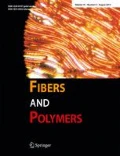Abstract
In this study, we introduce a new melt-spinning technology for producing basalt fibers on a laboratory scale and provide a dynamic model describing the basalt-fiber spinning process with the thermal effect in terms of an Arrhenius equation. The new trial system for basalt melt-spinning was established, while a microwave furnace was used to melt the quarried basalt rocks. And a susceptor, i.e., silicon carbide (SiC) was applied. A crucible with a one-hole bushing took the role of the spinning block, which was placed in the heating zone. A take-up device controlled by a PC was installed and the take-up speed was varied in order to investigate the fiber drawing effect on the thickness produced. Experimental results demonstrated that this new system is feasible for producing basalt fibers. The theoretical estimate of the fiber diameter profile with the Arrhenius viscosity description along the spinning line agreed well with the measurement. The diameter profile of the basalt fibers decreased with a funnel-shaped profile along the spinning line, while it changed very rapidly near the bushing hole up to the position 15 mm downwards, and then the fiber diameter decreased further up to the position 30 mm. In the remaining spinning zone the diameter reduction was very small. The gravitational effect of the molten basalt in the crucible on the fiber diameter was negligible.
Similar content being viewed by others
References
J. Militky and V. Kovacic, Text. Res. J., 66, 225 (1996).
J. Militky and V. Kovacic, Molecular Crystals and Liquid Crystals, 304, 55 (2000).
M. Botev, H. Betchev, D. Bikiaris, and C. Panayiotou, J. Appl. Polym. Sci., 74, 523 (1999).
T. Czigany, J. Vad, and K. Poloskei, Periodica Polytechnica Ser. Mech. Eng., 49, 3 (2005).
T. Czigany, Compos. Sci. Technol., 66, 3210 (2006).
P. I. Bashtannik, A. I. Kabak, and Y. Yakovchuk, Mech. Compos. Mater., 39, 85 (2003).
A. M. Zihlif and G. Ragosta, J. Thermoplastic Composite Materials, 16, 273 (2003).
B. K. Satapathy and J. Bijwe, J. Reinf. Plast. Comp., 24, 579 (2005).
B. Ozturk, F. Arslan, and S. Ozturk, Tribology International, 40, 37 (2007).
F. N. Rabinovich, V. N. Zueva, and L. V. Mekeeva, Glass and Ceramics, 58, 431 (2001).
D. Penteado Dias and C. Thaumaturgo, Cem. Concr. Compos., 27, 49 (2005).
J. S. Sim, C. W. Park, and D. Y. Moon, Compos. Part BEng., 36, 504 (2005).
G. J. Wang, Y. W. Liu, Y. J. Guo, Z. X. Zhang, M. X. Xu, and Z. X. Yang, Surface & Coating Technology, 201, 6565 (2007).
V. V. Gur’ev, E. I. Neproshin, and G. E. Mostovoi, Glass and Ceramics, 58, 62 (2001).
H. J. Kim, H. W. Yang, K. J. Jeon, and Y. Huh, Text. Sci. Eng., 46, 136 (2009).
Y. Huh, H. J. Kim, H. W. Yang, and K. J. Jeon, J. Korean Soc. Precision Eng., 26, 78 (2009).
C. Zhao, J. Vleugels, C. Groffils, P. J. Luypaert, and O. Van der Biest, Acta Materialia, 48, 3795 (2000).
S. Kase and T. Matsuo, J. Polym. Sci. Pol. Chem., 3, 2541 (1965).
S. Kase and T. Matsuo, J. Appl. Polym. Sci., 11, 251 (1967).
F. T. Geyling and G. M. Homsy, Glass Technology, 21, 95 (1980).
Author information
Authors and Affiliations
Corresponding author
Rights and permissions
About this article
Cite this article
Kim, J.S., Lim, J.H. & Huh, Y. Melt-spinning basalt fibers based on dielectric heating and steady-state process characteristics. Fibers Polym 14, 1148–1156 (2013). https://doi.org/10.1007/s12221-013-1148-6
Received:
Revised:
Accepted:
Published:
Issue Date:
DOI: https://doi.org/10.1007/s12221-013-1148-6



